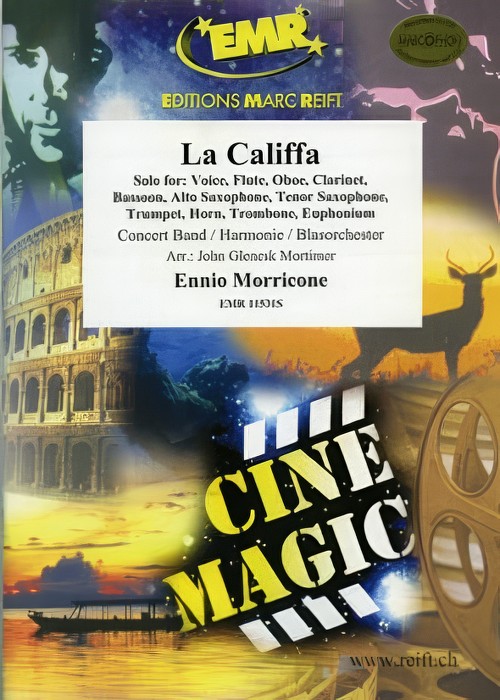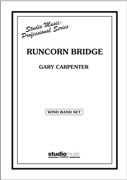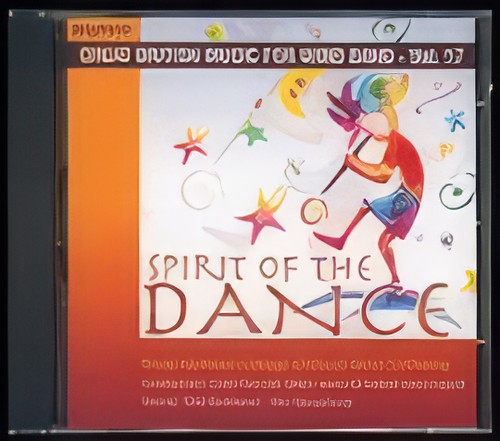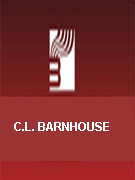Results
-
 £71.28
£71.28Dream Chaser
Dream Chaser is a spirited concert opener for high school band that captures the energy and emotion of those who choose to follow their dreams in any walk of life. The buoyant melodies of the opening measures later give way to a powerful and expressive section with brief solo opportunities for flute, clarinet, alto saxophone, tenor saxophone, and baritone. The piece concludes with both main themes returning in an exciting, flourishing, finish. A dynamic work to build the synergy of your ensemble!
Estimated dispatch 7-14 working days
-
£84.99
Joyful Saxophones (Concert Band - Score and Parts)
Joyful Saxophones is an exciting work. full of Latin-American flair, that highlights your saxophone section of two alto and one tenor saxophone, accompanied by rest of the band. A perfect way to put you saxes in the shine! 03:45
Estimated dispatch 7-14 working days
-
 £115.00
£115.00La Califfa (Flexible Solo with Concert Band - Score and Parts) - Morricone, Ennio - Mortimer, John Glenesk
Solo for Voice, Flute, Oboe, Clarinet, Bassoon, Alto Saxophone, Tenor Saxophone, Trumpet, Horn, Trombone or EuphoniumDuration: 3.30
Estimated dispatch 7-14 working days
-
 £104.99
£104.99Marching Blues Wind Band Set (Score & Parts)
Marching Blues was written in the blues and swing-jazz style of the great big bands. It is an ideal show march that can be used for encores, popular performances, family concerts and much more. It is unusual in that it features a 28 bar solo for tuba, tenor saxophone, or baritone saxophone. From small ensembles to large bands, Marching Blues will bring great joy to all generations of performers and audiences at any occasion. 0:04:00
Estimated dispatch 7-14 working days
-
 £174.95
£174.95RUNCORN BRIDGE (Professional Concert Band - Score and Parts) - Carpenter, Gary
The through-arch bridge that is visible for miles across the Cheshire Gap is one of two adjacent bridges that cross both the River Mersey and Manchester Ship Canal. Its formal name is the Silver Jubilee Bridge is more usually known as the Runcorn Bridge. Runcorn Bridge begins with a brief, quiet, introduction featuring an oboe solo. There follows a lively march at the end of which a reflective interlude (or bridge!) based upon the tune that occurs twice in the march leads to a lyrical, almost nocturnal section spotlighting the alto saxophone. A variant of the first interlude leads to a scherzo-like section kicked off by the euphonium with a 'trio' that contains a Latin-inflected version of the oboe melody first heard in the introduction. A third interlude variant heralds a return of the nocturnal melody firstly as a horn solo but subsequently returning to the alto saxophone. Previous melodic materials gradually combine as an extended crescendo leads to a majestic, but short, coda that in a gesture of symmetrical solidarity refers back to the march tune utilised in the earlier interludes. Duration: 10:30. Recorded on Polyphonic QPRM160D Bells Across the Atlantic.
Estimated dispatch 7-14 working days
-
 £37.95
£37.95RUNCORN BRIDGE (Professional Concert Band - Score only) - Carpenter, Gary
The through-arch bridge that is visible for miles across the Cheshire Gap is one of two adjacent bridges that cross both the River Mersey and Manchester Ship Canal. Its formal name is the Silver Jubilee Bridge is more usually known as the Runcorn Bridge. Runcorn Bridge begins with a brief, quiet, introduction featuring an oboe solo. There follows a lively march at the end of which a reflective interlude (or bridge!) based upon the tune that occurs twice in the march leads to a lyrical, almost nocturnal section spotlighting the alto saxophone. A variant of the first interlude leads to a scherzo-like section kicked off by the euphonium with a 'trio' that contains a Latin-inflected version of the oboe melody first heard in the introduction. A third interlude variant heralds a return of the nocturnal melody firstly as a horn solo but subsequently returning to the alto saxophone. Previous melodic materials gradually combine as an extended crescendo leads to a majestic, but short, coda that in a gesture of symmetrical solidarity refers back to the march tune utilised in the earlier interludes. Duration: 10:30. Recorded on Polyphonic QPRM160D Bells Across the Atlantic.
Estimated dispatch 7-14 working days
-
 £51.48
£51.48Saxes On The Seas
This lighthearted selection of sea chanteys provides a great opportunity for even the saltiest saxophone section to shine! Tunes including "Blow The Man Down," "Drunken Sailor," "A-Roving," and "Sailor's Hornpipe" provide great teaching moments as well as great fun for your audiences! A delightful selection designed to feature your saxophone section in a fun and crowd-pleasing way!
Estimated dispatch 7-14 working days
-
 £13.95
£13.95SPIRIT OF THE DANCE (Royal Northern College of Music Wind Orchestra) (CD)
Great British Music for Wind Band Vol.17 Royal Northern College of Music Wind Orchestra conducted by Clark Rundell, Mark Heron & Rafael Sanz-Espert. Guest Soloist: Rob Buckland (Saxophone).Includes:Their Finest Hour (A Portrait Overture) (Nigel Clarke)A Norfolk Rhapsody (Martin Ellerby)Looking In (A Self-Portrait) (Tom Davoren)Cinnamon Concerto (for Solo Alto Saxophone/Concert Band) (Martin Ellerby)Harlech Variants (Duncan Stubbs)Spirit of the Dance (Rob Wiffin)
Estimated dispatch 7-14 working days
-
 £39.60
£39.60Symphony No.1 Theme (Concert Band - Score and Parts)
The Johannes Brahms Symphony No. 1 Theme is designed to give your best players an opportunity to play a solo with band accompaniment. This solo is the same one that appears on page 36, book 1 of The Yamaha Advantage for oboe, bassoon, alto clarinet, tenor saxophone and horn. This arrangement also includes solo parts for Flute, Clarinet and Alto Saxophone. This piece can also be performed by band alone.
Estimated dispatch 7-14 working days
-
 £44.55
£44.55The Gladiator (Concert Band - Score and Parts)
An outstanding new composition for the solo instrument of your choice with band accompaniment. The Band Set includes solo parts for F Horn, Alto Saxophone, Tenor Saxophone, Bb Clarinet, Oboe and a piano reduction of the score so that the soloist can rehearse without the band being present. Besides being a great way to show off your young players, it's also a charming program number. Tremendous appeal!
Estimated dispatch 7-14 working days
